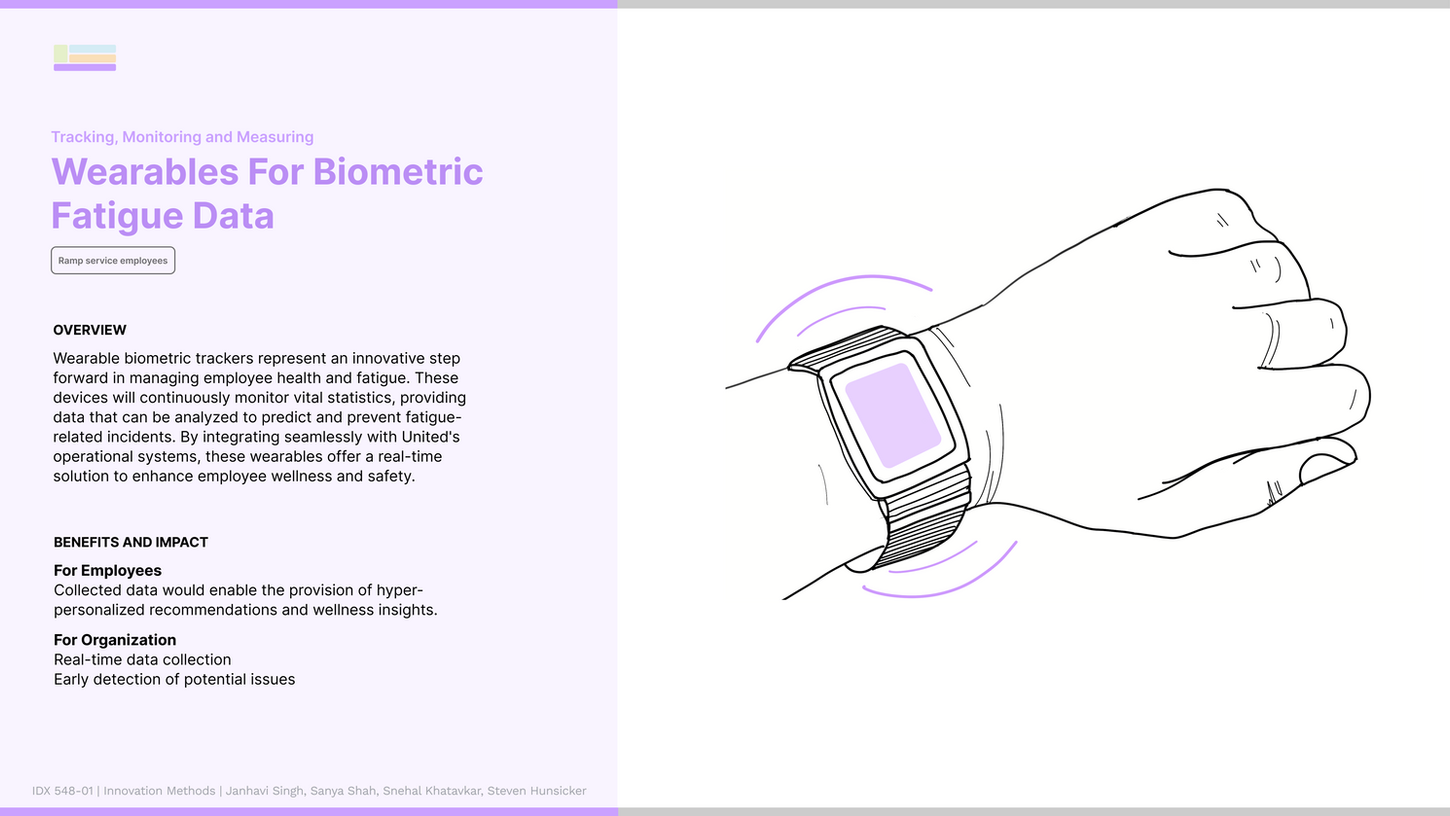Design research | Innovation strategy
Fatigue management system to prevent injuries and accidents in airport ground staff
Embedding Human Centered Design in the Innovation process
CONTEXT
Airport ground staff like ramp workers and baggage handlers ensure efficiency and customer satisfaction in aviation
Air travel depends on the seamless coordination of backend processes, with airport ground staff, like ramp workers and baggage handlers, playing a critical role. Their time-sensitive tasks, such as refueling, maintenance checks, and luggage handling, are essential to preventing delays and ensuring smooth airline operations and customer satisfaction.

PROBLEM
However, the high-risk working environments lead to chronic fatigue causing injuries and accidents in airport ground employees

Impact on employees
Annually, around 243,000 people
globally are injured in ground
operations incidents.
Impact on the organization
Ramp accidents cost major airlines worldwide at least US$10 billion
a year.
RESEARCH AND ANALYSIS
We took a rigorous research approach examining
future trends, abstracted the problem to understand how other industries were solving this challenge, and conducting ethnographic observations to get operational insights.

Trends analysis
Examined the macro-environmental shift and ‘new normal’ to future proof strategy

Case studies
By abstracting our problem, we examined how other organizations addressed similar challenges

SME interviews
Conducted interviews with 6 SMEs to understand system insights

Field observation
Observed airport ground operations to get operational insights
INSIGHTS
Insight 1
Fatigue is Complex
Fatigue is multifaceted, and elusive, originating from various sources and capable of manifesting in numerous ways.
Insight 2
The safety efficiency
trade-off
The scheduling systems prioritizes operational efficiency at the cost of team culture and employee well-being.
Insight 3
Under utilized data
United is underutilizing existing data to
understand injury occurrence and make
effective changes
CHALLENGE FROM UNITED AIRLINES
While pilots and crew often receive attention,
"under the wing" employees, like baggage handlers, face significant challenges. Recognizing the issue of fatigue-related injuries among these workers, United Airlines partnered with the Institute of Design to address it.

Reduce fatigue related injuries in the airport ground staff using process adjustments and
technology advancements
INNOVATION STRATEGY
The innovation strategy is a holistic approach, revealing that effective management cannot rely on a single solution. This perspective shapes our framework, which aims for comprehensive strategy implementation by addressing all critical facets.
.png)
SOLUTION ECOSYSTEM
Following the framework, we developed a balanced mix of solutions ranging from immediate, low-tech approaches to far-horizon, technologically advanced innovations. This strategy creates a holistic, end-to-end ecosystem that addresses various aspects of the challenge, ensuring both immediate impact and long-term resilience.
Performance safety and efficiency
.png)
Design principle
Prioritize safety actions with clear environmental signals and strong communication.
OPPORTUNITY FRAMING
How might we empower both United Airlines and its
employees to proactively address fatigue, striking a balance between employee wellbeing and operations safety. Crafting a holistic strategy, targeting fatigue from both a top-down and on-the-ground perspective
Optimized Operations

Design principle
Incorporate a comprehensive & holistic range of fatigue-related data for enhanced operational
decision-making.
Tracking, monitoring and fatigue
.png)
Design principle
Integrate devices and captured data seamlessly into existing systems to cultivate a personalized
understanding of fatigue and establish a
continuous feedback loop
Education and awareness
.png)
Design principle
Foster shared responsibility for fatigue management by empowering employees
STORYBOARD
This storyboard illustrates how each solution integrates into an employee's day, showcasing the interconnected touchpoints that form a cohesive support system.

THE FATIGUE RISK MANAGEMENT APPROACH
The map serves as a summary of our approach, offering a systems-level view of the proposed system. It illustrates how each element connects and supports the main goal, providing a holistic understanding of the system's workings and integration across its components.

STRATEGIC ROADMAP
Our project roadmap strategically sequences the introduction of innovations, enabling a realistic development of organizational capabilities. This phased approach begins with wave 1 for initial testing and learning, followed by wave 2 to build full functionality for sustained growth, and concludes with wave 3 to extend and adapt the system, maximizing value and attracting new audiences. By prioritizing actions, timing, and adjustments, this roadmap ensures alignment of innovations with both near-term and long-term growth objectives.
.png)
Brief
Collaborated with United Airlines to develop a comprehensive system to identify, measure, and monitor fatigue in airport ground personnel, by proposing a holistic understanding of fatigue, integrating technological advancements and process adjustments.
Impact
Aligned 3 different stakeholder groups on a unified understanding of fatigue to make safety a strategic goals within the organisation.
Duration
14 weeks
Role
Team of 4 members, Led the research initiative
Methods
Trends analysis, ethnographic observation, case studies, innovation strategy.








